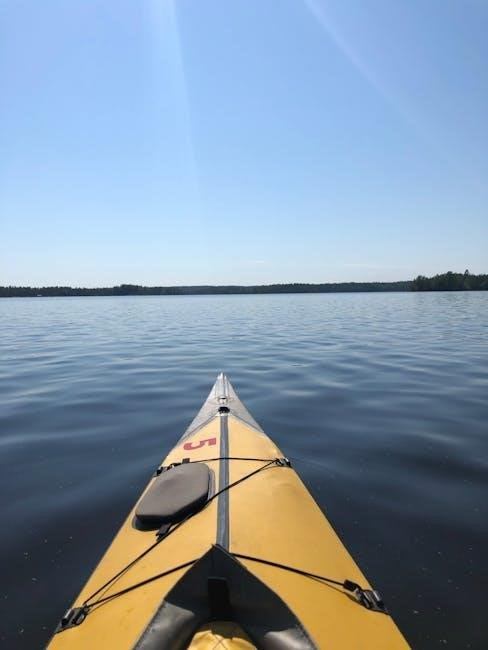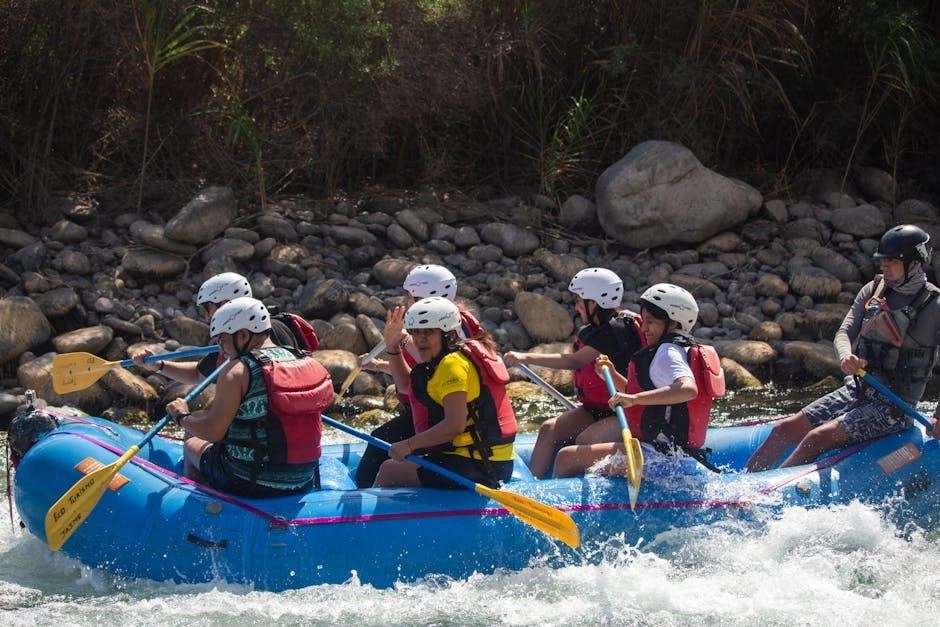Purchasing a kayak is a significant decision, requiring research and consideration of your needs, budget, and preferences. This guide helps you make an informed choice, ensuring you find the perfect kayak for your adventures. Whether you’re a beginner or an experienced paddler, understanding the options and features is crucial for an enjoyable experience on the water. Start by identifying your primary use case, such as recreational paddling, touring, or fishing, and then explore the types of kayaks that best suit your goals. A well-chosen kayak will enhance your time on the water and provide lasting satisfaction.
1.1. Why Buy a Kayak?
Owning a kayak offers unparalleled freedom to explore waterways, enjoy nature, and stay active. It provides a versatile way to fish, tour, or simply relax on the water. Kayaks are cost-effective compared to boats, requiring minimal maintenance and no fuel. They also offer a great workout, improving cardiovascular health and strength. Additionally, kayaks allow you to access remote areas inaccessible by larger vessels, making them ideal for adventure seekers. Investing in a kayak opens up a world of recreational and fitness opportunities.
1.2. Understanding Your Needs
Assessing your needs is crucial when selecting a kayak. Consider where and how often you’ll use it, as well as your skill level and preferences. Determine if you’ll primarily paddle on calm waters, rivers, or open seas. Think about whether you’ll use it for recreation, fishing, or touring. Frequency of use and storage space also matter. Understanding these factors ensures you choose a kayak that aligns with your lifestyle and enhances your kayaking experience;
1.3. Budget Considerations
Setting a budget is essential when purchasing a kayak. Prices vary widely based on type, material, and features. Entry-level kayaks are more affordable, while high-end models offer advanced features but at a higher cost. Consider not just the initial purchase but also ongoing expenses like maintenance, storage, and accessories. Allocating your budget wisely ensures you find a kayak that meets your needs without financial strain. Researching options within your price range helps make the decision process smoother.
Types of Kayaks
Kayaks vary widely, catering to different paddling styles and environments. Recreational, touring, inflatable, whitewater, and fishing kayaks are popular options, each designed for specific purposes and preferences.
2.1. Recreational Kayaks
Recreational kayaks are ideal for calm waters like lakes, slow rivers, or coastal areas. They are perfect for beginners due to their stability and ease of maneuverability. Designed for casual outings, these kayaks typically feature a shorter length and wider hull, making them highly buoyant and easy to handle. They often include comfortable seating and storage compartments for day trips. If you’re looking for a fun, stress-free paddling experience, recreational kayaks are an excellent choice for exploring serene environments.
2.2. Touring Kayaks
Touring kayaks are designed for long-distance paddling on open waters, such as oceans, large lakes, or rivers. They are sleek, narrow, and longer, offering greater speed and efficiency. These kayaks are ideal for experienced paddlers seeking adventure over multiple days. Featuring ample storage capacity for gear, they are perfect for multi-day trips. Touring kayaks often include hatches for secure storage and a cockpit designed for comfort during extended use. Their lightweight materials, like fiberglass or carbon fiber, enhance durability and performance.
2.3. Inflatable Kayaks
Inflatable kayaks are lightweight, portable, and ideal for casual paddling. They are easy to transport and store, making them perfect for beginners or those with limited space. These kayaks are durable, with high-quality models offering excellent performance on calm waters. Inflatable kayaks are versatile, suitable for lakes, slow rivers, or even mild whitewater. They often feature comfortable seating and ample space for gear, making them a practical choice for recreational use. Their affordability and ease of use make them a popular option for many paddlers.
2.4. Whitewater Kayaks
Whitewater kayaks are designed for navigating rough, fast-moving water and rapids. These kayaks are shorter and more maneuverable, ideal for experienced paddlers seeking thrilling adventures. Built for durability, they often feature robust materials to withstand impacts. Whitewater kayaks prioritize responsiveness and control, allowing quick turns and precise handling. They typically include safety features like self-bailing systems to keep water out. These kayaks are perfect for those who enjoy the adrenaline of tackling challenging rivers and rapids, requiring advanced skills and physical fitness for optimal performance.
2.5. Fishing Kayaks
Fishing kayaks are specifically designed for anglers, offering stability and space for gear. These kayaks often feature flat bottoms for calm waters and wide beams for increased stability, making them ideal for standing or casting. They include built-in rod holders, storage compartments, and mounting points for accessories like fish finders. Many models are pedal-driven, allowing hands-free navigation, which is perfect for fishing. Additionally, some fishing kayaks are inflatable, providing portability and ease of transport. They cater to both freshwater and saltwater environments, offering versatility for different fishing conditions.
Consider Your Skill Level
Choosing a kayak that matches your skill level is crucial for a safe and enjoyable experience. Beginners benefit from stable, easy-to-maneuver designs, while advanced paddlers may prefer performance-oriented models.
3.1. Beginner-Friendly Kayaks
Beginner-friendly kayaks prioritize stability and ease of use, making them ideal for those new to paddling. These kayaks typically feature wider hulls for better balance and are lightweight for easy handling. They often include ergonomic seating and intuitive controls, ensuring comfort during extended trips. Recreational kayaks are a popular choice for beginners, offering versatility in calm waters such as lakes, rivers, or coastal areas. They are designed to build confidence and skill, providing a smooth transition into more advanced kayaking.
3.2. Intermediate Kayaks
Intermediate kayaks are designed for paddlers with some experience, offering a balance of stability and performance. These kayaks are versatile, suitable for a variety of water conditions, including lakes, rivers, and coastal areas. They typically feature improved tracking and maneuverability compared to beginner kayaks, with a slightly narrower hull for better speed. Intermediate kayaks often include additional features like storage compartments and adjustable seating, catering to those who want to explore further or paddle for longer durations.
3.3. Advanced Kayaks
Advanced kayaks are tailored for experienced paddlers seeking high performance and precision. These kayaks are lightweight, with sleek designs for speed and agility. They often feature narrow hulls for better tracking and advanced maneuverability, making them ideal for challenging conditions like rapids or open seas. Advanced kayaks may include specialized features such as adjustable cockpits, thigh braces, and foot pedals for optimal control. Durability is key, with high-end materials ensuring longevity. They cater to paddlers who demand superior performance and are willing to invest in premium quality.

Kayak Frame and Material
Kayak frames come in inflatable or rigid designs, with materials ranging from durable plastics to lightweight composites. Each option offers unique benefits in performance, durability, weight, and maintenance.
4.1. Inflatable vs. Rigid Kayaks
Inflatable kayaks offer portability and ease of storage, making them ideal for casual use and tight spaces. They are lightweight, durable, and resistant to scratches, yet often more affordable. Rigid kayaks, typically made of plastic, fiberglass, or composite materials, provide superior speed, stability, and longevity. While heavier and bulkier, they excel in performance and durability for serious paddlers. Choosing between them depends on your priorities: convenience or performance.
4.2. Pros and Cons of Each Type
Inflatable kayaks are lightweight, portable, and ideal for casual use, offering easy storage and transport. They are durable and resistant to scratches but may lack the speed and maneuverability of rigid kayaks. Rigid kayaks, while heavier and bulkier, provide superior performance, stability, and longevity. They excel in various water conditions but require more storage space and effort to transport. Consider your priorities: inflatable for convenience or rigid for performance and durability.
Size and Weight Capacity
Choosing the right kayak size ensures optimal performance and efficiency. Consider paddler size, intended use, and stability needs. Weight capacity affects buoyancy and handling; select a kayak that meets your requirements;
5.1. Choosing the Right Length
Kayak length significantly impacts performance. Longer kayaks (12-14 feet) offer better tracking and speed, ideal for touring. Shorter kayaks (8-10 feet) provide maneuverability, suitable for recreational use. Consider your paddling environment. For calm waters, a mid-length kayak (10-12 feet) balances stability and efficiency. Ensure the length aligns with your skill level and intended use. Proper length enhances control and comfort, making your paddling experience enjoyable.
5.2. Understanding Weight Limits
Weight limits are crucial for safe and efficient kayaking. Exceeding the limit can compromise stability and performance. Consider your weight, gear, and passengers when selecting a kayak. Longer, wider kayaks typically support more weight, while shorter, narrower ones are better for lighter users. Always check the manufacturer’s specifications to ensure the kayak meets your needs. Proper weight distribution enhances safety and comfort on the water.

Key Features to Look For
Stability, storage capacity, seating comfort, and durability are essential features. Consider maneuverability, weight limits, and accessory options to enhance your kayaking experience.
6.1. Stability and Maneuverability
Stability and maneuverability are crucial factors in choosing a kayak. A stable kayak provides confidence, especially for beginners, while maneuverability affects how easily it turns. Wider kayaks offer greater stability but may sacrifice some speed. Narrower kayaks are faster but less stable. Consider your paddling environment: calm waters may favor stability, while dynamic conditions demand better maneuverability. Hull design and length play significant roles in these aspects, ensuring a balance that matches your skill level and intended use.
6.2. Storage Capacity
Storage capacity is essential for kayaks, especially if you plan extended trips or need space for gear. Touring and fishing kayaks often feature large hatches, compartments, and tank wells for storing equipment. Consider the size and placement of storage areas to ensure easy access and keep items dry. For recreational use, smaller compartments may suffice. Assess your needs for dry storage, as this impacts safety and comfort during paddling. Adequate storage enhances your kayaking experience, allowing you to carry essentials securely.
6.3. Seating and Comfort
Seating and comfort are crucial for an enjoyable kayaking experience. Look for adjustable seats with ample cushioning and back support to prevent fatigue during long paddles. Legroom and footrests should also be considered to ensure proper posture and comfort. Some kayaks feature molded seats or removable cushions for added convenience. Testing the seat’s comfort before purchase is highly recommended, as it directly impacts your ability to enjoy extended time on the water. A well-designed seat enhances overall paddling comfort and reduces strain.
Kayak Materials and Durability
Kayaks are made from durable materials like plastic, fiberglass, or inflatable options. Each material offers unique benefits, such as resistance to UV rays or impact. Regular maintenance ensures longevity and optimal performance on the water.
7.1. Plastic vs. Composite Materials
Plastic kayaks are durable and affordable, ideal for casual use. Composite materials, like fiberglass or carbon fiber, offer lighter weight and better performance but are more expensive. Choosing between them depends on your budget, paddling frequency, and performance expectations. Plastic kayaks are low-maintenance and resistant to scratches, making them perfect for beginners or those seeking a hassle-free option. Composite kayaks, while pricier, provide superior maneuverability and speed for serious paddlers. Both options ensure a reliable and enjoyable kayaking experience.
7.2. UV Resistance and Maintenance
UV resistance is crucial for maintaining your kayak’s condition, especially for plastic models, as prolonged sun exposure can cause fading and brittleness. Regular cleaning and storage in shaded areas help preserve the material. Applying UV protectants can further enhance durability. Composite kayaks are less prone to UV damage but still benefit from proper care. Regular maintenance ensures your kayak remains in optimal condition, extending its lifespan and performance. Always follow manufacturer guidelines for care to keep your kayak looking and performing its best.

Accessories and Gear
Essential accessories include paddles, life jackets, and sprayskirts. Storage options like dry bags and kayak carts enhance convenience. Additional gear such as fishing gear or lighting can customize your experience.
8.1. Essential Accessories
Essential accessories for kayaking include a durable paddle, a properly fitting life jacket, and a sprayskirt to keep water out of the cockpit. Dry bags or waterproof storage containers are crucial for keeping gear dry during trips. A kayak cart or trolley is also a must for easy transportation to and from the water. Additionally, consider a paddle leash to prevent losing your paddle and a bilge pump or sponge for draining water from the kayak. These items ensure safety, comfort, and efficiency on the water.
8.2. Optional but Useful Gear
Optional but useful gear for kayaking includes a kayak light for visibility in low-light conditions, a compass for navigation, and a fishing crate if you plan to fish. A cushion or seat pad can enhance comfort, while a hydration pack helps stay water during long trips. Paddle gloves reduce blisters, and a camera allows you to capture memories. Additionally, a hat and sunglasses provide sun protection, and a small first-aid kit is always a wise precaution. These items can enhance your kayaking experience but aren’t essential for getting started.

Budget and Cost Implications
When planning to buy a kayak, consider your budget and the costs involved. Prices vary widely based on the type, material, and features of the kayak.
9.1. Entry-Level Kayaks
Entry-level kayaks are perfect for beginners, offering affordability and durability. Made from high-quality plastic, they withstand rough handling and are designed for calm waters. These kayaks emphasize stability and ease of maneuverability, making them ideal for casual paddling. They typically weigh less and feature comfortable seating, ensuring a pleasant experience for new paddlers. Entry-level models are a great first purchase, allowing users to gain experience before upgrading to more specialized kayaks.
9.2. Mid-Range Kayaks
Mid-range kayaks offer a balance between quality and affordability, catering to paddlers seeking improved performance. These kayaks are crafted from durable materials and often feature lightweight designs for easier transport and handling. They provide better tracking and maneuverability compared to entry-level models, making them suitable for both calm and slightly challenging waters. Mid-range kayaks typically include additional features like storage compartments and adjustable seating, enhancing comfort and versatility for a variety of paddling experiences. They are an excellent choice for those looking to upgrade without a significant investment.
9.3. High-End Kayaks
High-end kayaks are designed for serious paddlers seeking superior performance, durability, and advanced features. Constructed from premium materials like carbon fiber or high-grade composites, these kayaks offer exceptional lightweight and strength. They feature superior tracking, stability, and maneuverability, making them ideal for long-distance touring or challenging conditions. High-end models often include customizable seating, ample storage, and cutting-edge accessories. While they come with a higher price tag, their unmatched quality and performance make them a worthwhile investment for dedicated enthusiasts. They are built to last and deliver unparalleled paddling experiences.
Reading Reviews and Recommendations
Researching reviews and recommendations is crucial for informed kayak purchasing. Explore user feedback, expert opinions, and ratings to gauge performance, durability, and value. This step ensures you make the best choice tailored to your needs and preferences, avoiding costly mistakes and enhancing your paddling experience.
10.1. Where to Find Reliable Reviews
Reliable kayak reviews can be found on reputable websites like REI, Amazon, and specialized outdoor gear forums. These platforms offer detailed user feedback, ratings, and expert opinions. Additionally, paddling communities and social media groups provide firsthand experiences. Always cross-reference multiple sources to ensure unbiased assessments. Reading through several reviews helps identify consistent themes and potential issues, aiding in making an informed decision.
10.2. Understanding User Feedback
Understanding user feedback is crucial when evaluating kayaks. Pay attention to consistent themes, such as durability, performance, and comfort. Positive reviews often highlight ease of use and stability, while negative feedback may focus on weight or storage limitations. Look for reviews from paddlers with similar needs and skill levels to yours. This helps ensure the feedback is relevant and applicable to your specific use case. Analyzing multiple perspectives provides a balanced view, aiding in making an informed decision.
Trying Before Buying
Test paddling a kayak before purchasing is highly recommended. This hands-on experience allows you to assess performance, comfort, and handling in real water conditions. Many dealers offer demo days or rentals, enabling you to compare models and find the best fit for your needs. Don’t hesitate to try different options to ensure your final choice is the right one.
11.1. Test Paddling Options
Test paddling is a crucial step in selecting the right kayak. Many dealers offer demo days or rental opportunities, allowing you to experience different models firsthand. This hands-on approach lets you assess stability, maneuverability, and comfort in real water conditions. Take advantage of these options to compare various kayaks and identify the one that best suits your paddling style and needs. Testing before buying ensures confidence in your purchase and helps avoid costly mistakes.
11.2. Rental vs. Purchase
Renting a kayak offers flexibility and lower upfront costs, ideal for occasional use or trying different models. Purchasing, however, provides long-term savings and personalization. Consider your budget, storage space, and frequency of use. Rentals are great for testing kayaks before committing, while buying ensures availability and customization. Weighing these factors helps determine the best option for your lifestyle and paddling goals. Both choices have advantages, so assess your needs carefully to make an informed decision.

Finalizing Your Purchase
Once you’ve selected your kayak, ensure all paperwork and payments are completed. Inspect the kayak for damage and confirm all features meet your expectations.
12.1. Where to Buy
When finalizing your purchase, consider buying from reputable retailers, both online and in-store. Online options like REI, Dick’s Sporting Goods, or specialty kayak shops offer convenience and wide selections. For a hands-on experience, visit local outdoor gear stores or kayak dealerships. Ensure the retailer provides warranties, return policies, and after-sales support. You can also check online marketplaces, but verify seller reliability. Local classifieds or paddling communities may offer used kayaks, but inspect them thoroughly before purchasing.
12.2. Negotiating the Price
Negotiating the price of a kayak is possible, especially when purchasing from a dealership or private seller. Timing is key—end-of-season sales or model-year closeouts often offer discounts. Inquire about package deals, including paddles or accessories, which may lower the overall cost. Be prepared to walk away if the price isn’t right, and don’t hesitate to ask for discounts based on minor flaws or floor models. Always research market prices beforehand to negotiate confidently.
This guide has provided essential insights to help you make an informed decision. By considering your needs, budget, and preferences, you’ll find the perfect kayak for your adventures. Enjoy your time on the water!
13.1. Final Tips for Buying the Right Kayak
When purchasing a kayak, prioritize research and test paddling to ensure the best fit for your needs. Consider your skill level, the type of water you’ll paddle on, and storage options. Reflect on your budget and long-term goals to avoid impulse buys. Seek advice from experienced paddlers or retailers to make an informed decision. Reading reviews and comparing models will help you find a kayak that aligns with your lifestyle and preferences, ensuring years of enjoyment on the water. Proper maintenance and storage will extend its lifespan.
13.2. Enjoying Your New Kayak
Owning a kayak opens up a world of adventure and relaxation. Explore serene lakes, rugged coastlines, or peaceful rivers, connecting with nature and clearing your mind. Always check weather conditions and water safety before paddling. Share the experience with friends or family to create lasting memories. Properly caring for your kayak ensures it remains in great condition for future trips. Embrace the freedom and joy that comes with paddling, and make the most of your time on the water.
